The importance of mitochondrial health: A user guide
Healthy mitochondria are the foundation of good health, science is uncovering. Learn why they matter and what you can do today to optimize them.
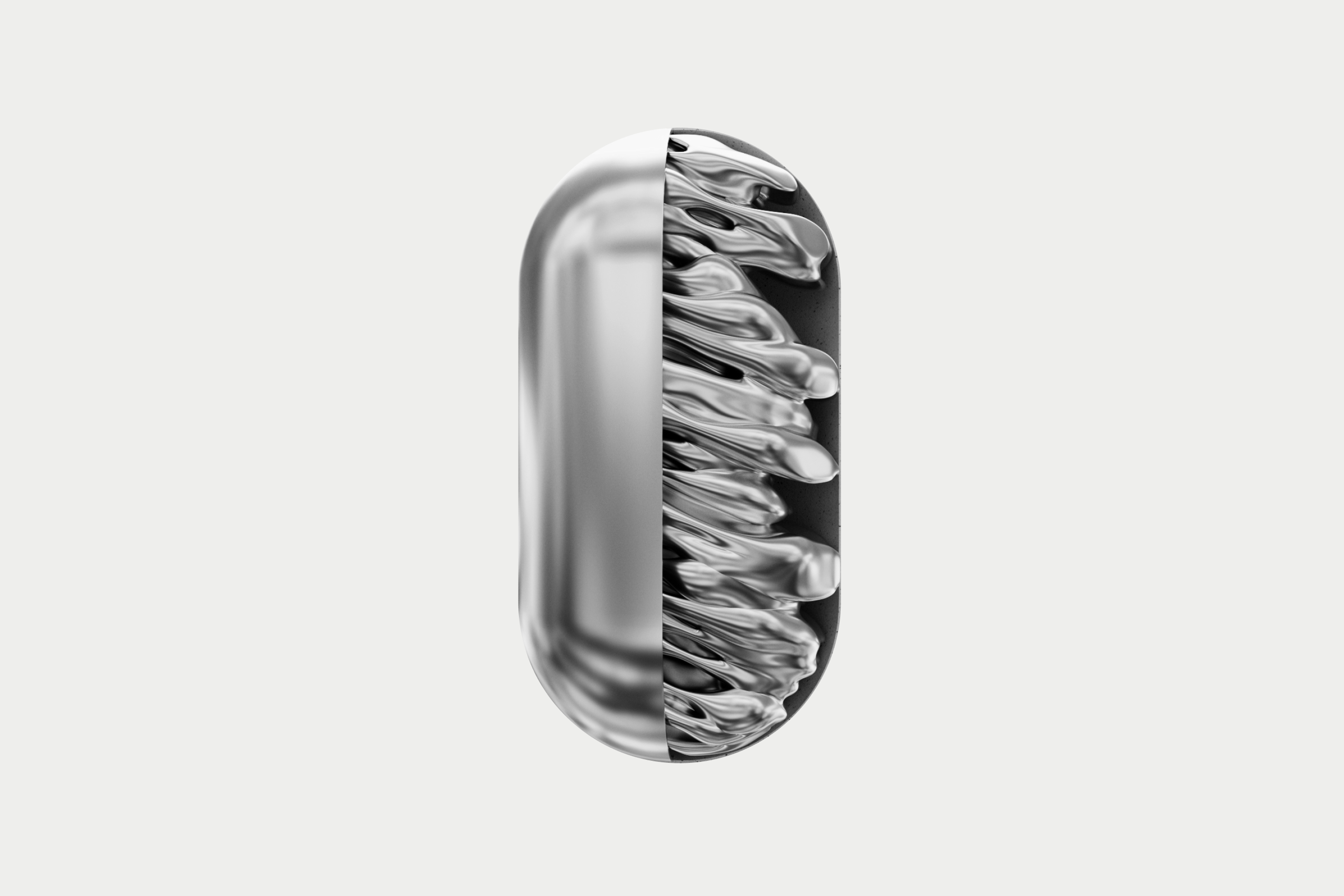
What to know
Mitochondria are specialized structures within our cells that are responsible for generating the energy we need to live. While the main role of the mitochondria is to create energy, they have other critical functions in the cell, including cellular communication, cell growth, and death, and providing building blocks for our genetic material.
The mitochondria take elements from the food we eat (carbohydrates, protein, and fat) combined with oxygen from the air we breathe to make energy (ATP) through a process called cellular respiration.
While cellular respiration provides the body with much-needed ATP, it generates free radicals as by-products which can damage the delicate mitochondria and their DNA, leading to mitochondrial dysfunction.
Mitochondrial dysfunction has been linked to aging and age-related conditions like muscle loss and neurodegenerative disease.
Focusing on the health of your mitochondria through diet, exercise, and targeted supplements like Mitopure can help to keep your mitochondria working better for improved health.
Mitochondria - your guide to cellular health and optimization
Meet your mitochondria, the tiny cellular components responsible for generating most of the energy we need to live our lives. While the scientific community has long been aware of the important role mitochondria play in health, only recently are they garnering more mainstream recognition.
In the past few years, mitochondria have been identified as significant players in the aging process,[1] and so, are being studied for their role in the development of age-related chronic conditions such as cancer, neurodegenerative disorders, cardiovascular disease, and age-related muscle decline. Anyone who is interested in increasing their health span will no doubt want to know more about these important structures.
If you’ve long forgotten high school biology, you may be asking yourself what are mitochondria and how do we keep them healthy? With Timeline Nutrition playing such an integral role in the scientific research surrounding mitochondrial health, we wanted to create the definitive user's guide, outlining everything you need to know about what they do and provide you with a toolbox to optimize their function.
What are mitochondria?
In simple words, mitochondria are specialized structures within our cells that are responsible for generating the energy we need to live. Think of them as microscopic factories that take raw materials like food and oxygen, and pass them through a complex assembly line to create energy.
Almost all of our cells contain mitochondria to fuel their energy demand. The concentration of mitochondria in cells varies based on their energy demand, so it is not surprising the heart, liver, brain, and muscles are dense with mitochondria. In fact, a single, active muscle cell can contain up to 2500-3000 mitochondria. Red blood cells are the exception; they do not contain any mitochondria.
What is the role of mitochondria?
The main role of the mitochondria is to create energy in the form of adenosine triphosphate (ATP). However, they have other critical functions in the cell as well. The mitochondria are involved in:
- Carbohydrate, protein, and fat metabolism
- Synthesis of fat and proteins
- Creating building blocks for our genetic material (RNA and DNA)
- Cellular communication
- Calcium balance within our body
- Cell growth and death
With so many important roles in the body, it’s clear to see why we should focus our attention on caring for these vital organelles.
What is mitochondrial DNA?
An interesting fact about the mitochondria is that they have their own DNA, distinct from the chromosomal DNA in our cells' nucleus. This DNA, called mtDNA, codes for many of the proteins needed for energy metabolism and is passed down exclusively from our mothers. The discovery of mtDNA fostered an intriguing theory — that mitochondria evolved from ancient bacteria that were engulfed by larger, more complex cells. They developed a symbiotic relationship with the host cell, providing them with much-needed energy. Over time, they evolved into complex multicellular organisms like us humans.
The discovery of mtDNA was groundbreaking because it led to the discovery of mitochondrial disease and the fact that mitochondrial dysfunction plays a role in many genetic disorders.
It should be noted that mtDNA is highly susceptible to damage, which may play a part in the development of mitochondrial dysfunction and the aging process.
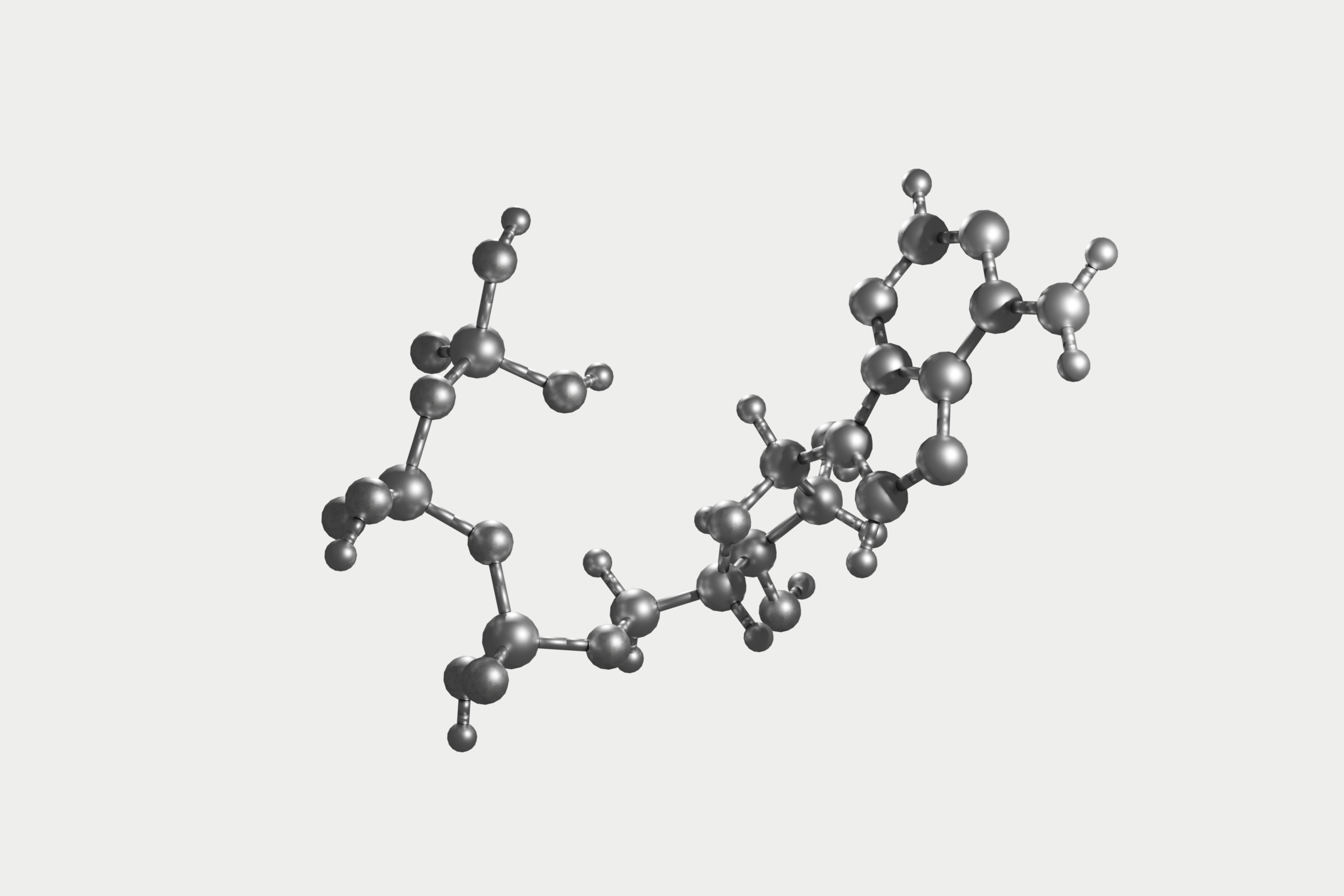
ATP Molecule
What does ATP mean?
ATP stands for adenosine triphosphate, and it is the form of energy our body uses to fuel all the biological processes that keep us alive. The name triphosphate stems from the fact that it has three phosphate molecules, where the available energy is stored. ATP releases energy when one of the phosphate bonds is broken.
ATP cannot be stored, so our mitochondria must work 24/7 to provide us with life-sustaining energy. As we age, their energy-generating capacity declines, which means our energy levels decline as well. Taking care of our mitochondria by triggering their renewal process may be the key to reversing the loss of ATP production.
Understanding energy metabolism
At an extremely high level, our mitochondria take elements from the food we eat (carbohydrates, protein, and fat) combined with oxygen from the air we breathe to make ATP through a process called cellular respiration.
They essentially act as a factory with a series of complex assembly lines. Food and oxygen pass through the production line with the assistance of nutrients, which behave much like workers and their tools. If a worker is absent or a piece of tool malfunctions, the entire production line can be held up, jeopardizing the end product.
There are three main steps to cellular respiration:
1. Glycolysis
2. The tricarboxylic acid cycle (also called the Krebs cycle or TCA cycle)
3. And oxidative phosphorylation
During this process, one molecule of glucose (a simple sugar that comes from the carbohydrates we eat) gets broken down into carbon dioxide and water, ultimately producing ATP.
Along the way, important coenzymes are generated: nicotinamide adenine dinucleotide (NADH) and flavin adenine dinucleotide (FADH2). They become electron donors that fuel the electron transport chain, part of the oxidative phosphorylation phase. This is the phase where most of the ATP gets made.
While cellular respiration provides the body with much-needed ATP, it generates free radicals as a by-product. Also called reactive oxygen species (ROS), these free radicals can damage the delicate mitochondria and their DNA, leading to mitochondrial dysfunction.
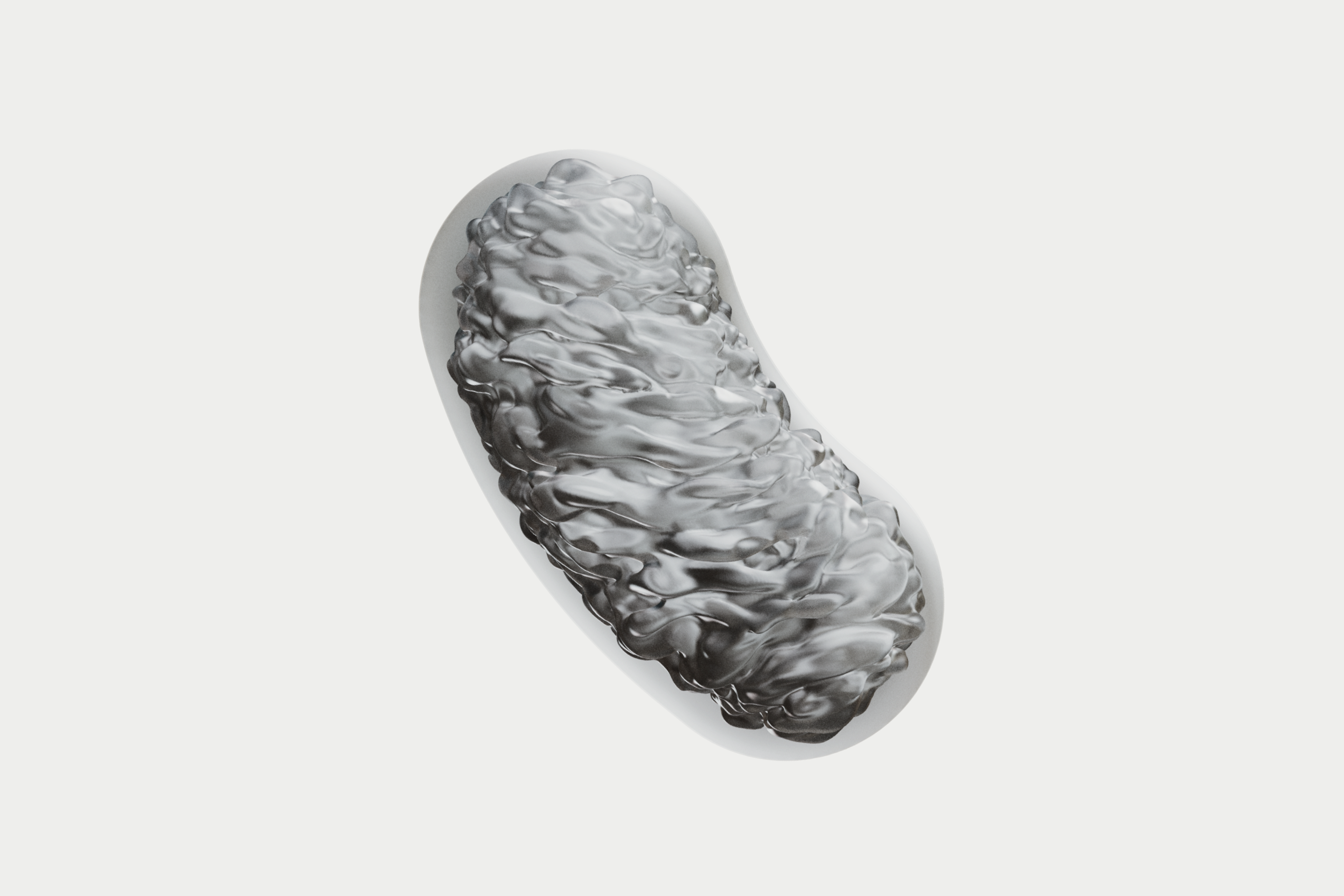
Dysfunctional mitochondrion
What is mitochondrial dysfunction?
Mitochondrial dysfunction occurs with the accumulation of ROS, triggering damage to the mitochondria and their DNA. Mitochondrial dysfunction has been linked to several chronic conditions, including:
- Mitochondrial disease
- Age-related muscle decline
- Age-related hearing loss
- Early aging
- Diabetes
- Certain cancers
- Neurodegenerative disorders such as Alzheimer's disease, dementia, ALS, and Parkinson's
- Autism
- Chronic fatigue syndrome
Our cells have developed a critical recycling process to maintain the health of our mitochondria. This process is called mitophagy.
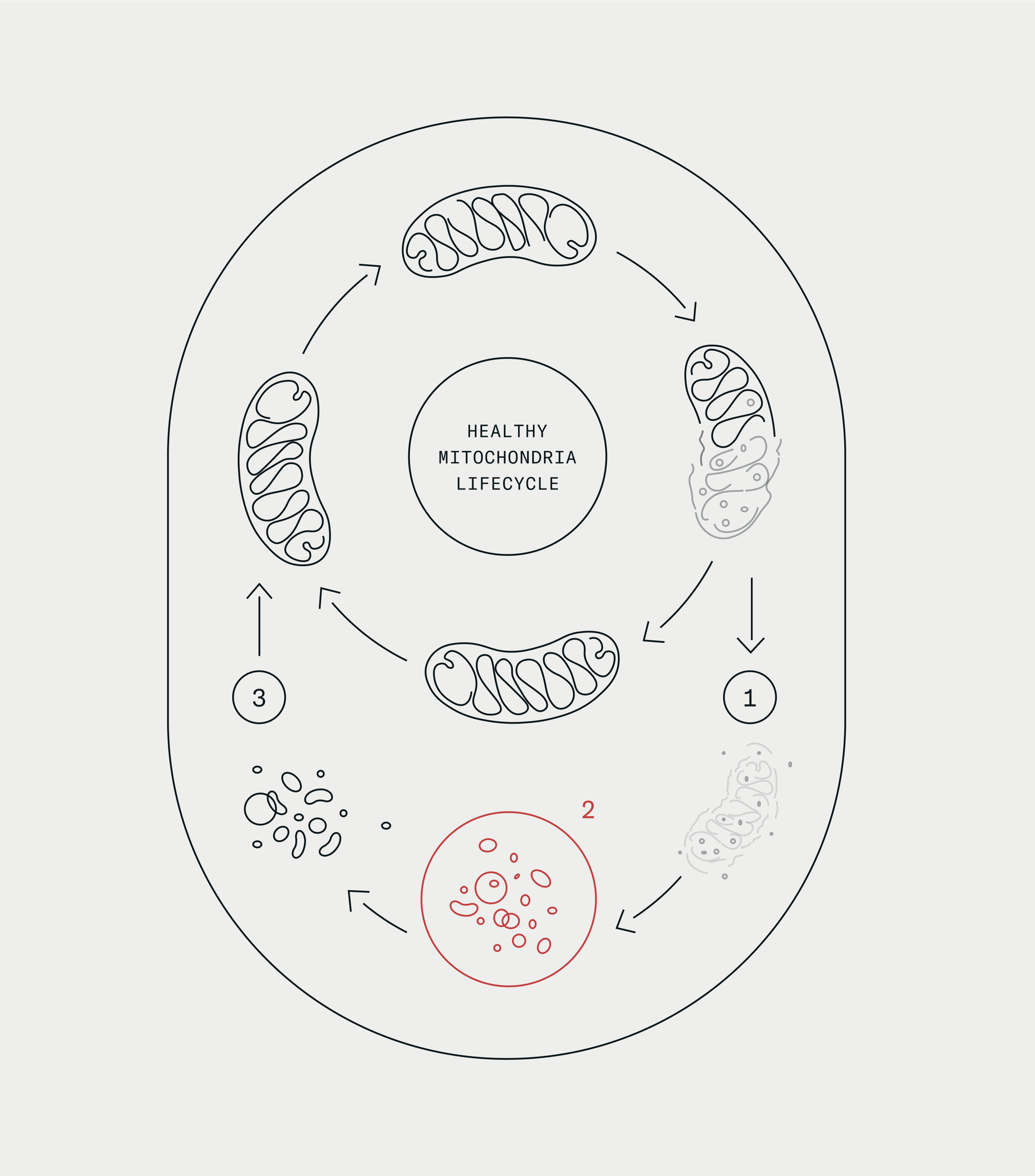
1: Fission: Mitochondria are broken down into smaller fragments and any that are damaged are separated so that they can be targeted by mitophagy. / 2: Mitophagy: Mitophagy is the removal and recycling of damaged mitochondria. Mitopure™ is the first cellular nutrition to trigger mitophagy, and proven to improve muscle function. / 3: Biogenesis: A process that takes place when new healthy mitochondria are regenerated by our cells and then fused with existing healthy ones.
What is mitophagy?
With mitochondria being so paramount to our very existence, it is no wonder that the body evolved a process to keep their health in check. Mitophagy is the cell’s quality control mechanism, where it rids itself of dysfunctional mitochondria and generates healthier, more efficient ones.
Mitophagy is a type of autophagy. Autophagy is the process by which damaged cellular components are degraded and removed from the cell so that these damaged parts don’t collect inside the cell.
New mitochondria are created by a process called biogenesis, where new healthy mitochondria are regenerated by our cells and then fused with existing healthy ones.
Research suggests that this important process declines as we age, implying that our ability to create healthy mitochondria to support our energy demands diminishes. Inducing mitophagy may be one way to reverse this reduction in function.
A step-by-step guide to mitochondrial health
Now that you understand just how important the tiny but mighty mitochondria are to energy creation and the aging process, you may be wondering what exactly you should be doing to keep them in tip-top shape.
That’s why we've created this simple but effective strategy to optimize your mitochondria.
1. Eat a healthy diet

The foundational step in your mitochondrial care plan is to focus on eating a well-balanced diet. Too many of us eat a diet full of processed foods and empty calories, which is taxing the mitochondria. Many Americans don't get enough of the crucial nutrients that support energy metabolism. Just like absent workers or broken tools on the assembly line, nutrient deficiencies will slow down ATP production. B vitamins, vitamin C, zinc, and chromium, are just a few of the essential workers in our mitochondrial production line. When they are lacking in the diet, our ability to generate energy is impacted.
Energy production is a risky business, with so many ROS produced as a byproduct. A diet rich in antioxidants will help offset the free-radical damage associated with generating ATP and offer protection to the delicate mtDNA.
In addition to what you eat, how much and when you eat may also play a role in optimizing your mitochondria. Intermittent fasting and caloric restriction appear to have a protective effect on the mitochondria and can stimulate autophagy..
2. Get plenty of exercise

It’s well known that regular physical activity is a necessary component of any wellness plan. Yet, researchers are now learning how exercise promotes longevity at a cellular level. It appears that exercise, particularly high-intensity interval training, improves age-associated decline in mitochondrial function in muscle cells. A regular exercise routine is a must-have for maintaining our mitochondrial health.
Question: What is the impact of longer continuous exercise sessions versus shorter bursts of exercise on mitochondrial function? A recent study compared the impact of 45 minutes of continuous exercise vs 5-minute active breaks every hour for 9 hours over 4 days to understand the impact on mitochondrial capacity and muscle function.
3. Optimize mitophagy

Like spring cleaning for your cells, mitophagy helps remove damaged mitochondria, making room for newer, healthier ones. As a potent inducer of mitophagy, it makes sense that Urolithin A should be the next step in your mitochondrial care plan. While Urolithin A can be made in the human gut from dietary precursors found in pomegranates, berries, and nuts, only 40% of people are able to make significant amounts of this powerful anti-aging molecule. The only way to ensure that you get a clinically proven dose of Urolithin A is from direct supplementation.

Mitopure Softgels
Bestseller4.4 · 3103 reviews
The simplest form of Mitopure
4. Targeted Supplementation
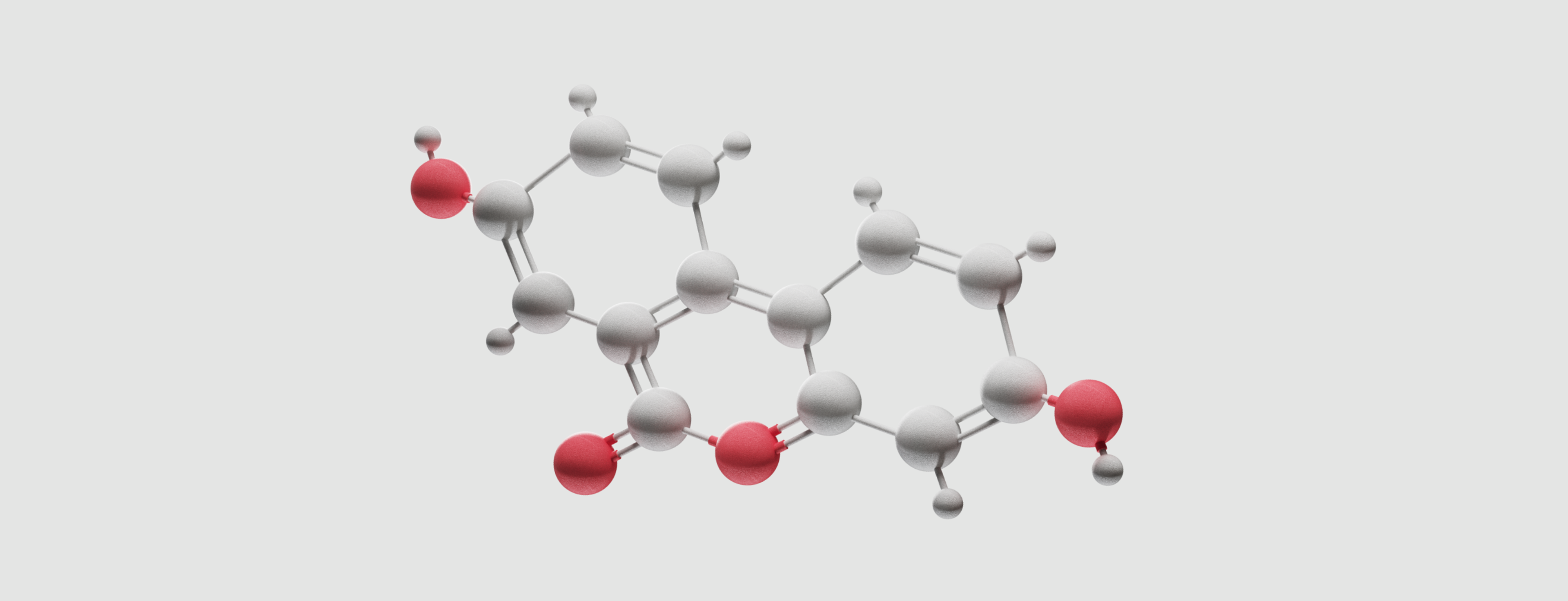
As people begin to embrace the role of mitochondrial optimization in promoting health and longevity, they are turning to advanced nutrition targeted at cellular health.
As there are several important nutrients the mitochondria need to do their work, targeted supplementation may be an important last step in your mitochondrial care plan. At the top of the supplement list lies Urolithin A due to its unique ability to induce mitophagy. A few other nutrients we think are worth noting include:
- NAD+ - As we learned above, NAD+ is a coenzyme that plays a vital role in energy metabolism as it accepts and donates hydrogen molecules as part of the electron transport chain. NAD+ levels decline as we age, and research suggests that supplementing with a precursor molecule (nicotinamide riboside) may help help to support energy metabolism and mitochondrial health.
- CoQ10 - Coenzyme Q10, also called ubiquinol-10, is made inside the mitochondria to act as an antioxidant to counteract free radical damage. This molecule's role in mitochondrial health has been highly studied, and it appears dietary supplementation may offer some benefit to our mitochondria.
- L-Carnitine - L-carnitine is an amino acid that helps to transport fatty acids into the mitochondria to be turned into energy. Because of this, people may use L-carnitine as a supplement to support weight loss. While there are mixed results on its use for weight loss, it does appear that supplementation can significantly increase mitochondrial function.
- B Vitamins - There are eight B vitamins, many of which play a central role in making sure that cellular respiration moves smoothly. A B-complex vitamin will supply at least 100% of the daily value for each B vitamin, ensuring that your mitochondria have the tools they need to do their job efficiently.
- Antioxidants - Vitamin E, vitamin C, selenium, glutathione, and alpha-lipoic acid are just a few antioxidants that may support mitochondrial health by balancing free radical damage.
There’s no doubt about it, mitochondria are essential to life. While there is still much to uncover about their role in aging and disease, we know our health is in their control. Learn more about the science behind Mitopure and how Urolithin A supports cellular performance and mitochondrial optimization.
Authors

Written by
Senior Manager of Nutrition Affairs
References
- ↑
Jang JY, Blum A, Liu J, Finkel T. The role of mitochondria in aging. J Clin Invest. 2018;128(9):3662-3670. doi:10.1172/JCI120842 (https://www.zotero.org/google-docs/?G1iFf1)
- ↑
Chinnery PF, Schon EA. Mitochondria. Journal of Neurology, Neurosurgery & Psychiatry. Published online September 2003. Accessed February 20, 2022. https://jnnp.bmj.com/content/74/9/1188

•
Nutrition•
First-of-Its-Kind Longevity Gummy Launched

•
Skincare•






